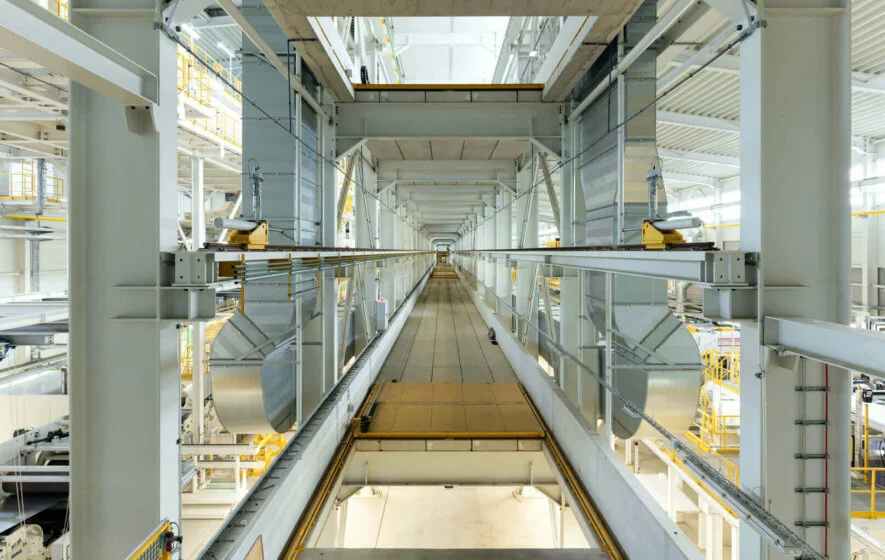The energy transition, digitisation and electrification are all steadily progressing. Demand for electricity is rising. At the same time, however, the number of power stations that can generate electricity around the clock is falling, as plants are decommissioned or put on stand-by, and Germany continues to phase out nuclear power. Given these conditions, how is it possible to ensure a reliable supply of electricity? One crucial part of the answer to this question will be the interaction of renewable energy and conventional power stations.
Tuesday, 24 January 2017, noon:
Thick clouds blot out the sun all over Germany and there is no wind to blow the clouds away: the ‘dark doldrums’ have arrived. Wind and solar power deliver less than five percent of the electricity needed, with another nine percent coming from regulated biomass and hydroelectric power. Conventional power stations are running at full capacity, but cannot cover demand entirely. Other than pumped storage power stations, there is no significant storage capacity. Germany has to import electricity.
Monday, 23 April 2018, 2 pm:
A sunny spring day with a brisk breeze in northern Germany. According to the Federal Network Agency, during the past hour renewables have supplied 44,210 megawatt hours (MWh) to the power grid, with 86 percent of this coming from wind and solar plants. At this time, total electricity consumption in Germany amounts to 69,082 MWh, an average figure for the middle of a working day. The remaining one third of the electricity needed comes from conventional stations. Over the last 24 hours, renewable energy and conventional energy sources have each covered around 50 percent of demand.
Tuesday, 1 May 2018, 1 pm:
Compared to the past weeks, it has been quite cool in Germany, even though the May sun has been shining repeatedly. It is possible that the strong winds are preventing things from getting warmer. At any rate, the wind is powering the wind turbines. Between 1 pm and 3 pm, renewables cover all of Germany’s electricity needs – for the first time ever. Wind and solar plants alone supply around 90 percent. But one thing is clear: the almost 105,000 MWh of renewable power generated during these two hours is only adequate because most companies are closed for Labour Day. On 2 May, a normal working day, consumption amounts to just over 136,000 MWh during the same timeframe.
Reliable power suppliers are increasingly unprofitable
Three examples and a rather average one. They illustrate how difficult electricity supply in Germany already is these days. And it does not appear that anything will change in the foreseeable future, because the modern industrial and service-oriented society hungers for increasing amounts of electricity: for clean mobility, competitive industries, wide-ranging data networks and smart building infrastructure.
While electricity consumption will likely continue to rise, more and more power stations with reliable capacity are being decommissioned. The phase-out of nuclear energy is set to end in 2022, eight lignite-fired units will also be placed on stand-by, and plant operators have notified the Federal Network Agency that other power stations will be decommissioned in the early 2020s.
According to the Federal Network Agency, 42 generation units with a capacity of more than 8,700 megawatts (MW) have been shuttered throughout Germany in recent years. As of April 2018, operators had applied for another 65 closures. The Federal Network Agency has temporarily rejected 20 of these, as the plants are considered to be system-critical.
Supply shortfall poses a threat to business locations
The German Association of Energy and Water Industries (BDEW) projects that the generation capacity of conventional power stations will decline from the current level of almost 90,000 MW to 75,300 MW by the early 2020s. On an average working day, together with biomass and hydro that would be sufficient even without generation from wind and solar plants. However, annual peak consumption in Germany regularly exceeds 80,000 MW.
In such cases, Germany would perhaps no longer be able to meet its needs on its own, warned Julius Ecke, an energy market expert at enervis energy advisors. Furthermore, this would drive up electricity costs: “We expect that electricity prices for consumers and even more so for industry would increase, by up to five euros per megawatt hour,” according to Ecke.
This is hardly likely to please anyone. And it could actually represent an existential threat to energy-intensive industrial operations such as Norsk Hydro’s aluminium plant in the Rhenish town of Grevenbroich: Every year, the company’s almost 2,000 workers process more than half a million metric tons of aluminium into foils, lithographic products, aluminium strip, can lids and products for the automotive and construction industries. The plant also has a foundry for high-purity aluminium. It melts the metal at a temperature of 660 degrees Celsius, and that takes a lot of energy.
This is exactly why the aluminium works were set up next to a power plant back in 1922. As Volker Backs, Managing Director of Hydro Aluminium Deutschland GmbH, explained, “We compete at the international level and cannot afford any production outages. We rely on electricity, even when the wind farms are not producing any.”
We are moving towards an increasingly administered electricity system and tend to get into conflicts with the European single market. At the latest, this kind of regulatory approach will have to be revised when plant closures can no longer be prevented due to age considerations and investment in new power stations becomes necessary. Dietmar Lindberger, Institute of Energy Economics (EWI) at the University of Cologne
Independent national initiatives are harmful for the climate and competition
Germany’s Federal Network Agency is working to avoid capacity shortfalls by prohibiting plant closures. However, this policy will not be viable for much longer, according to economist Dietmar Lindenberger from the Institute of Energy Economics (EWI) at the University of Cologne in an interview with the energy periodical Energiewirtschaftliche Tagesfragen: “We are moving towards an increasingly administered electricity system and tend to get into conflicts with the European single market. At the latest, this kind of regulatory approach will have to be revised when plant closures can no longer be prevented due to age considerations and investment in new power stations becomes necessary.”
Because as Lindenberger points out, it is still the case that “electricity generated from wind and solar power can replace fuel, but it can hardly replace power stations when it comes to covering peak demand”.
Photo credits: Gorodenkoff, shutterstock.com, Shliakhtun Volha, shutterstock.com

